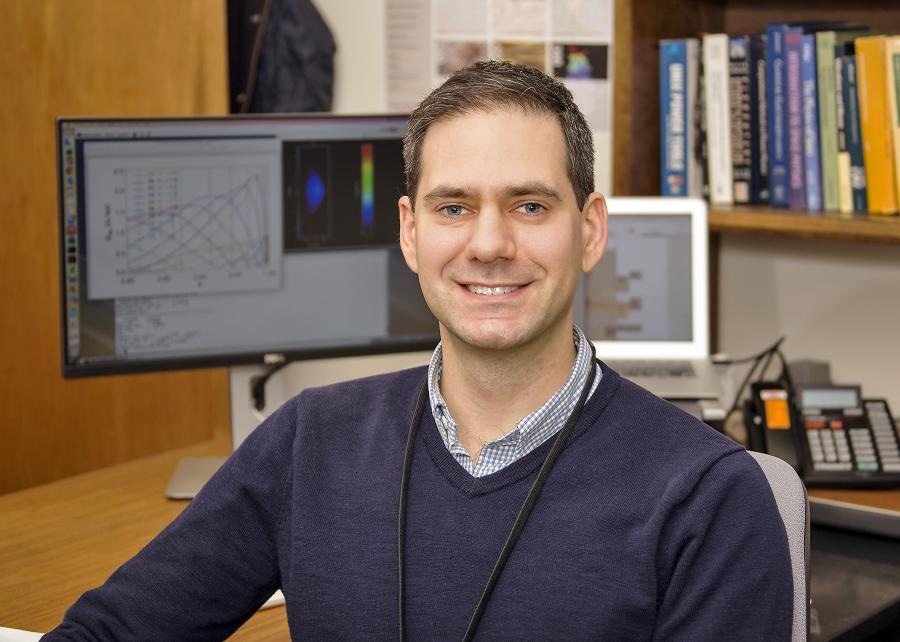Aug 6 2019
Magnetic fields are generally used by researchers to bottle up and regulate the fusion reactions on Earth. Since these fusion reactions power the stars and sun, any errors in the shape of the fields containing the reactions should be corrected.
 Physicist Nate Ferraro (Image credit: Elle Starkman/Office of Communications)
Physicist Nate Ferraro (Image credit: Elle Starkman/Office of Communications)
Errors like that create deviations from the symmetrical form of the fields in doughnut-like tokamak fusion facilities that can have an adverse effect on the confinement and stability of the hot, charged plasma gas that powers the reactions.
Headed by scientists at the U.S. Department of Energy’s (DOE) Princeton Plasma Physics Laboratory (PPPL), a research team has discovered that error fields are clearly present in the initial 10-week run of the National Spherical Torus Experiment—Upgrade (NSTX-U), the leading fusion facility at the laboratory.
The thorough detection technique used by the team can offer lessons for error correction in upcoming fusion devices like ITER—the large international fusion facility being built in France to show the viability of controlled fusion energy.
Fusion Powers the Sun and Stars
Fusion is the power that fuels the stars, and sun. It can be described as the fusing of light elements in the form of plasma—the hot, charged state of matter made up of free electrons as well as atomic nuclei—that produces huge amounts of energy. Globally, researchers are looking for ways to simulate fusion on Earth for an almost unlimited supply of power to produce electricity.
In order to identify the source of the NSTX-U error fields, PPPL scientists have put together a combination of comprehensive measurement of the position of the magnets, experimental data, and computer modeling of the plasma’s response.
The analysis exposed a spectrum of tiny error fields—an unavoidable outcome of the fact that a tokamak cannot be flawlessly symmetrical—however, most had an easily correctible effect on the plasma. Yet, one important finding stood out—a subtle misalignment of the magnetic coils that run down the core of the tokamak and generate the fields that wrap “toroidally” or horizontally around the vessel’s interior.
The Clue Scientists Sought
This slight misalignment was the clue researchers were looking for.
We looked for the source of the error with the biggest impact on the plasma. What we found was a small misalignment of the center-stack coils with the casing that encloses them.
Nate Ferraro, Study First Author and Physicist, Princeton Plasma Physics Laboratory, U.S. Department of Energy
Ferraro reported the search and findings in Nuclear Fusion.
The subtle misalignment produced errors that resonated in the plasma behavior. Among the problems was a braking and locking effect that prevented the plasma edge from rotating, and also increased localized heating on plasma-facing components within the tokamak.
After the discovery of the misalignment, the tokamak was shut down for ongoing maintenance in the wake of a coil failure. The findings related to the misalignment are currently being utilized “to drive new engineering tolerance requirements for NSTX-U as it is rebuilt,” stated the scientists.
Such kinds of needs call for tighter tolerance between the center stack and the casing enclosing it. Moreover, a tighter tolerance may narrow the deviation from the optimal alignment of both components to below two one-hundredths of an inch along the center stack’s vertical axis.
According to the authors, the adjustment would not only reduce concerns relating to increased localized heating but would also reduce the magnetic braking and locking effect. Such advancements would thus enhance the plasma stability.
Every tokamak is concerned about error fields. What we are trying to do is optimize the NSTX-U.
Nate Ferraro, Study First Author and Physicist, Princeton Plasma Physics Laboratory, U.S. Department of Energy
Partnering with the NSTX-U Experiment
The study findings expose the link between the NSTX-U experiment and the PPPL Theory Department, stated Amitava Bhattacharjee, who heads Theory.
“This is an excellent example of the NSTX-U-Theory Partnership program that has been beneficial for both the NSTX-U and Theory Departments at PPPL, and which continues even when NSTX-U is in recovery,” stated Bhattacharjee.
The research team members included scientists from PPPL, General Atomics, Sandia National Laboratory, and Oak Ridge National Laboratory.
The study was funded by the DOE Office of Science (Fusion Energy Sciences).